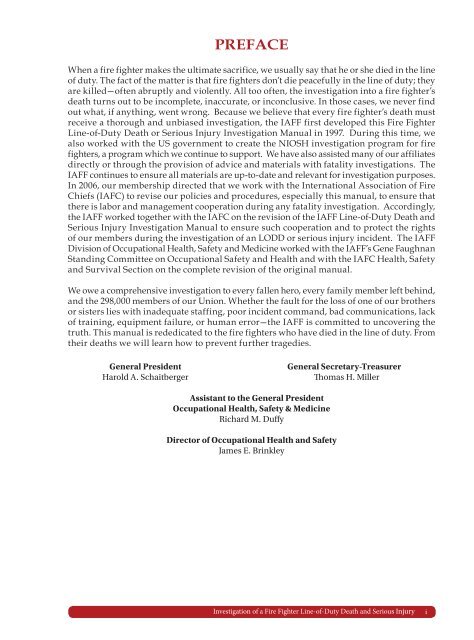Manual - International Association of Fire Fighters
Manual - International Association of Fire Fighters
Manual - International Association of Fire Fighters
You also want an ePaper? Increase the reach of your titles
YUMPU automatically turns print PDFs into web optimized ePapers that Google loves.
PREFACE<br />
When a fire fighter makes the ultimate sacrifice, we usually say that he or she died in the line<br />
<strong>of</strong> duty. The fact <strong>of</strong> the matter is that fire fighters don’t die peacefully in the line <strong>of</strong> duty; they<br />
are killed—<strong>of</strong>ten abruptly and violently. All too <strong>of</strong>ten, the investigation into a fire fighter’s<br />
death turns out to be incomplete, inaccurate, or inconclusive. In those cases, we never find<br />
out what, if anything, went wrong. Because we believe that every fire fighter’s death must<br />
receive a thorough and unbiased investigation, the IAFF first developed this <strong>Fire</strong> Fighter<br />
Line-<strong>of</strong>-Duty Death or Serious Injury Investigation <strong>Manual</strong> in 1997. During this time, we<br />
also worked with the US government to create the NIOSH investigation program for fire<br />
fighters, a program which we continue to support. We have also assisted many <strong>of</strong> our affiliates<br />
directly or through the provision <strong>of</strong> advice and materials with fatality investigations. The<br />
IAFF continues to ensure all materials are up-to-date and relevant for investigation purposes.<br />
In 2006, our membership directed that we work with the <strong>International</strong> <strong>Association</strong> <strong>of</strong> <strong>Fire</strong><br />
Chiefs (IAFC) to revise our policies and procedures, especially this manual, to ensure that<br />
there is labor and management cooperation during any fatality investigation. Accordingly,<br />
the IAFF worked together with the IAFC on the revision <strong>of</strong> the IAFF Line-<strong>of</strong>-Duty Death and<br />
Serious Injury Investigation <strong>Manual</strong> to ensure such cooperation and to protect the rights<br />
<strong>of</strong> our members during the investigation <strong>of</strong> an LODD or serious injury incident. The IAFF<br />
Division <strong>of</strong> Occupational Health, Safety and Medicine worked with the IAFF’s Gene Faughnan<br />
Standing Committee on Occupational Safety and Health and with the IAFC Health, Safety<br />
and Survival Section on the complete revision <strong>of</strong> the original manual.<br />
We owe a comprehensive investigation to every fallen hero, every family member left behind,<br />
and the 298,000 members <strong>of</strong> our Union. Whether the fault for the loss <strong>of</strong> one <strong>of</strong> our brothers<br />
or sisters lies with inadequate staffing, poor incident command, bad communications, lack<br />
<strong>of</strong> training, equipment failure, or human error—the IAFF is committed to uncovering the<br />
truth. This manual is rededicated to the fire fighters who have died in the line <strong>of</strong> duty. From<br />
their deaths we will learn how to prevent further tragedies.<br />
General President<br />
Harold A. Schaitberger<br />
General Secretary-Treasurer<br />
Thomas H. Miller<br />
Assistant to the General President<br />
Occupational Health, Safety & Medicine<br />
Richard M. Duffy<br />
Director <strong>of</strong> Occupational Health and Safety<br />
James E. Brinkley<br />
Investigation <strong>of</strong> a <strong>Fire</strong> Fighter Line-<strong>of</strong>-Duty Death and Serious Injury<br />
i

















